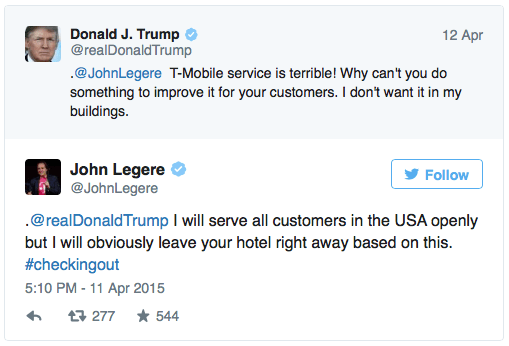Did you know that nearly 80% of cellular calls occur indoors? Despite cellular subscriber penetration rates that have exceeded 100% in many countries, indoor coverage still varies considerably. With the rise of #GenMobile, subpar coverage is no longer acceptable. More than ever, customers, students, and employees are demanding decent cellular coverage in their buildings. Complaints about spotty coverage can drag down customer satisfaction benchmarks like hospital HCACPS scores and can also launch spectacular Twitter wars.

John Legere is a Twitter phenom and the CEO of T-Mobile USA
So if indoor cellular coverage is so important, why aren't more venues doing something about it? Simply put, existing indoor coverage solutions are too expensive and complex, even for the largest organizations. Fortunately, Wi-Fi calling promises a revolutionary and cost-effective alternative for the masses.
Last week, we held a well-anticipated two-part webinar series on Wi-Fi calling. Customers from a broad set of industries including higher ED, general enterprise, and healthcare shared our enthusiasm for providing indoor cellular coverage through Wi-Fi technology. We discussed the technology disruption that Wi-Fi calling will create in the indoor coverage market, along with how organizations can prepare their Wi-Fi networks for this killer new app.
If you missed the recorded sessions, you can find them here:
Part 1: Downfall of Femtocells, Small Cells and Indoor DAS – A review of Wi-Fi calling compared to other legacy indoor coverage solutions.
Part 2: The Calm Before the Storm – Key technical considerations needed to support a strong Wi-Fi calling experience on your network.
For those interested in the cliff notes, here are some of the highlights.
- Since the introduction of the first iPhone, indoor mobile data has long defaulted to Wi-Fi. With Wi-Fi calling, voice will transition to Wi-Fi when a user is indoors. This essentially makes Wi-Fi access points the new affordable small cell. Do we still need expensive indoor coverage for the majority of indoor spaces? Can we stop discussing DAS (Distributed Antenna System), LTE small cells, or LAA/LTE-U as the only options for indoor coverage?
- The history of Wi-Fi calling is a fascinating one. It has been around for quite some time (remember UMA?), but the feature was too early for its time and a variety of business dynamics inhibited early adoption.
- With newfound carrier and manufacturer support, Wi-Fi calling will succeed this time around. Carriers and venues finally have a scalable and affordable coverage option to preserve customer loyalty. Customers will embrace it for the improved coverage, reduced minutes used, and roaming avoidance.
- There will be a learning curve associated with Wi-Fi calling as carriers, infrastructure providers (like Aruba), and customers fine-tune their implementations over time.
- Don't give Wi-Fi calling a bad name! A good experience requires a proper network design. Wi-Fi administrators need to reevaluate their coverage, roaming, QoS, and troubleshooting to ensure success. Aruba features like AppRF and ClientMatch, along with new standards like 802.11k,v,r are Wi-Fi calling's new BFFs.
- Even if you have DAS — and are a one-percenter:-p — you'll likely still care about Wi-Fi calling for secondary or tertiary cellular providers not supported on your DAS system.
The webinar audience questions came in fast and furious during our live session. Here are some notable ones.
General
Q: Do cellular providers typically allow Wi-Fi calling outside their service area?
A: Capabilities will vary based on the provider.
Q: Will VoIP over Wi-Fi require more bandwidth?
A: VoIP requires accurate classification, prioritization, and optimized roaming. Bandwidth will not really be a concern in the 11ac world.
Q: You mentioned that DNS queries for the ePDG had a certain structure. Would you share that structure response? Does it contain 3GPP or some other key texts?
A: The 3GPP format is like this: ss.epdg.epc.mnc260.mcc310.pub.3gppnetwork.org. While we have seen some operators follow this, others have their own format.
Configuration
Q: Is there a way to disable/block Wi-Fi calling if you know your Wi-Fi network is not ready for it?
A: Yes, upcoming AppRF capabilities will allow you to disable based on flows and traffic type.
Q: Typical beacon intervals are 100 milliseconds. Should this or other advanced options be increased?
A: We don't usually increase the beacon interval. Detailed recommendations for voice traffic is in our Validated Reference Design docs http://community.arubanetworks.com/t5/Validated-Reference-Design/tkb-p/Aruba-VRDs (try the "roaming devices" one first)
Q: Will Wi-Fi calling or UCC capabilities require a separate license?
A: No, they will not require new licenses, but PEF licensing is required.
Q: What is the recommended minimum AP density?
A: Approximately 50 feet of linear separation between APs (refer to the VRD).
Q: How many of these monitoring/optimization features will be supported with Aruba Instant? Will a controller become necessary as Wi-Fi calling is used more?
A: Although the controller may ultimately present richer UCC dashboards and capabilities, Instant will support the ALG for detection and classification in a future release. Additionally, Airwave can be leveraged for monitoring.
Q: What version of AOS supports 802.11 k,v,r?
A: AOS 6.3 and later.
Q: What version of AOS will detect and classify Wi-Fi calling?
A: An AOS release targeted for 2HCY15.
Looking for more info? If you're a tech history buff, read my piece on Wi-Fi calling that was published on No Jitter today.
Alan Ni is a director of solutions marketing at Aruba, a Hewlett Packard Enterprise company.




